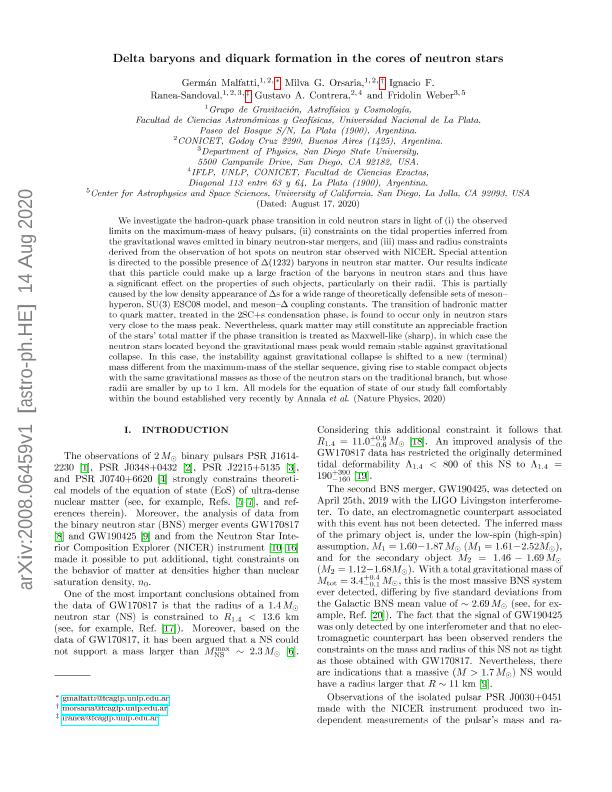Mostrar el registro sencillo del ítem
dc.contributor.author
Malfatti, Germán

dc.contributor.author
Orsaria, Milva Gabriela

dc.contributor.author
Ranea Sandoval, Ignacio Francisco

dc.contributor.author
Contrera, Gustavo Aníbal Gabriel

dc.contributor.author
Weber, Fridolin

dc.date.available
2021-09-13T17:13:05Z
dc.date.issued
2020-09-09
dc.identifier.citation
Malfatti, Germán; Orsaria, Milva Gabriela; Ranea Sandoval, Ignacio Francisco; Contrera, Gustavo Aníbal Gabriel; Weber, Fridolin; Delta baryons and diquark formation in the cores of neutron stars; American Physical Society; Physical Review D: Particles, Fields, Gravitation and Cosmology; 102; 6; 9-9-2020; 1-18
dc.identifier.issn
2470-0010
dc.identifier.uri
http://hdl.handle.net/11336/140211
dc.description.abstract
We investigate the hadron-quark phase transition in cold neutron stars in light of (i) the observed limits on the maximum-mass of heavy pulsars, (ii) constraints on the tidal properties inferred from the gravitational waves emitted in binary neutron-star mergers, and (iii) mass and radius constraints derived from the observation of hot spots on neutron star observed with the Neutron Star Interior Composition Explorer instrument. Special attention is directed to the possible presence of Δ(1232) baryons in neutron star matter. Our results indicate that this particle could make up a large fraction of the baryons in neutron stars and thus have a significant effect on the properties of such objects, particularly on their radii. This is partially caused by the low density appearance of Δs for a wide range of theoretically defensible sets of meson-hyperon, SU(3) ESC08 model, and meson-Δ coupling constants. The transition of hadronic matter to quark matter, treated in the 2SC+s condensation phase, is found to occur only in neutron stars very close to the mass peak. Nevertheless, quark matter may still constitute an appreciable fraction of the stars' total matter if the phase transition is treated as Maxwell-like (sharp), in which case the neutron stars located beyond the gravitational mass peak would remain stable against gravitational collapse. In this case, the instability against gravitational collapse is shifted to a new (terminal) mass different from the maximum-mass of the stellar sequence, giving rise to stable compact objects with the same gravitational masses as those of the neutron stars on the traditional branch, but whose radii are smaller by up to 1 km. All models for the equation of state of our study fall comfortably within the bound established very recently by Annala et al.
dc.format
application/pdf
dc.language.iso
eng
dc.publisher
American Physical Society

dc.rights
info:eu-repo/semantics/openAccess
dc.rights.uri
https://creativecommons.org/licenses/by-nc-sa/2.5/ar/
dc.subject
Neutron Stars
dc.subject
QCD phase transition
dc.subject
Hyperons
dc.subject
NJL model
dc.subject.classification
Física de Partículas y Campos

dc.subject.classification
Ciencias Físicas

dc.subject.classification
CIENCIAS NATURALES Y EXACTAS

dc.subject.classification
Astronomía

dc.subject.classification
Ciencias Físicas

dc.subject.classification
CIENCIAS NATURALES Y EXACTAS

dc.subject.classification
Física Nuclear

dc.subject.classification
Ciencias Físicas

dc.subject.classification
CIENCIAS NATURALES Y EXACTAS

dc.title
Delta baryons and diquark formation in the cores of neutron stars
dc.type
info:eu-repo/semantics/article
dc.type
info:ar-repo/semantics/artículo
dc.type
info:eu-repo/semantics/publishedVersion
dc.date.updated
2021-09-06T17:02:11Z
dc.identifier.eissn
2470-0029
dc.journal.volume
102
dc.journal.number
6
dc.journal.pagination
1-18
dc.journal.pais
Estados Unidos

dc.journal.ciudad
New York
dc.description.fil
Fil: Malfatti, Germán. Universidad Nacional de La Plata. Facultad de Ciencias Astronómicas y Geofísicas; Argentina. Consejo Nacional de Investigaciones Científicas y Técnicas. Centro Científico Tecnológico Conicet - La Plata; Argentina
dc.description.fil
Fil: Orsaria, Milva Gabriela. Universidad Nacional de La Plata. Facultad de Ciencias Astronómicas y Geofísicas; Argentina. Consejo Nacional de Investigaciones Científicas y Técnicas. Centro Científico Tecnológico Conicet - La Plata; Argentina
dc.description.fil
Fil: Ranea Sandoval, Ignacio Francisco. Universidad Nacional de La Plata. Facultad de Ciencias Astronómicas y Geofísicas; Argentina. Consejo Nacional de Investigaciones Científicas y Técnicas. Centro Científico Tecnológico Conicet - La Plata; Argentina. San Diego State University; Estados Unidos
dc.description.fil
Fil: Contrera, Gustavo Aníbal Gabriel. Consejo Nacional de Investigaciones Científicas y Técnicas. Centro Científico Tecnológico Conicet - La Plata. Instituto de Física La Plata. Universidad Nacional de La Plata. Facultad de Ciencias Exactas. Instituto de Física La Plata; Argentina
dc.description.fil
Fil: Weber, Fridolin. San Diego State University; Estados Unidos. University of California at San Diego; Estados Unidos
dc.journal.title
Physical Review D: Particles, Fields, Gravitation and Cosmology

dc.relation.alternativeid
info:eu-repo/semantics/altIdentifier/doi/http://dx.doi.org/10.1103/PhysRevD.102.063008
dc.relation.alternativeid
info:eu-repo/semantics/altIdentifier/url/https://journals.aps.org/prd/abstract/10.1103/PhysRevD.102.063008
dc.relation.alternativeid
info:eu-repo/semantics/altIdentifier/arxiv/https://arxiv.org/abs/2008.06459
Archivos asociados
